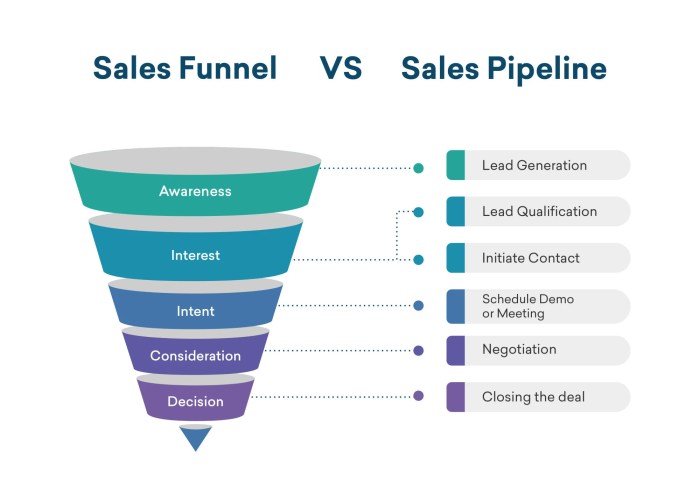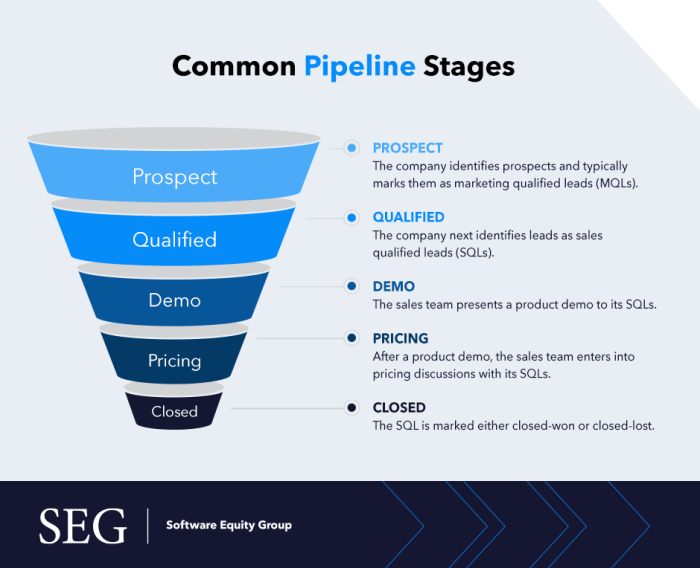Understanding the Sales Pipeline sets the stage for a journey into the world of strategic sales processes and revenue growth. Get ready to dive into the ins and outs of how businesses can thrive by mastering this essential concept.
From defining the sales pipeline to exploring key metrics and overcoming challenges, this topic offers a comprehensive guide to help businesses succeed in today’s competitive market.
Understanding the Sales Pipeline

In the world of sales, a sales pipeline is like a roadmap that guides you through the entire sales process, from identifying potential leads to closing deals. It helps sales teams track and manage their interactions with customers, ensuring a systematic approach to selling.
Stages of a Typical Sales Pipeline
- Prospecting: This is where the sales team identifies and qualifies potential leads. It involves researching and reaching out to prospects to gauge their interest in the product or service.
- Initial Contact: Once a lead is identified, the sales team makes initial contact to introduce the product or service and gather more information about the prospect’s needs.
- Qualification: In this stage, the sales team determines if the prospect is a good fit for the product or service based on their budget, authority to make decisions, needs, and timeline.
- Proposal: After qualifying the prospect, the sales team presents a proposal that Artikels the product or service, pricing, and terms of the deal.
- Closing: The final stage involves negotiating terms, addressing any objections, and ultimately closing the deal.
Benefits of a Well-Structured Sales Pipeline
- Improved Efficiency: A well-structured sales pipeline helps sales teams prioritize leads, focus on high-quality prospects, and streamline the sales process.
- Forecasting Accuracy: By tracking deals at each stage of the pipeline, companies can better predict sales revenue and identify potential bottlenecks in the sales process.
- Enhanced Customer Relationships: A systematic approach to selling ensures that customers receive consistent communication and support throughout the sales cycle, leading to stronger relationships and increased customer satisfaction.
Sales Pipeline Management: Understanding The Sales Pipeline
Effective sales pipeline management is crucial for businesses to ensure a steady flow of revenue and maximize sales opportunities. By properly managing the sales pipeline, companies can track and monitor the progress of deals, identify potential bottlenecks, and streamline the sales process for improved efficiency.
Key Strategies for Managing and Optimizing a Sales Pipeline
- Regularly review and update pipeline stages: It is essential to regularly review and update the stages of your sales pipeline to ensure accurate tracking of deal progress.
- Qualify leads effectively: Implement a lead scoring system to prioritize leads based on their likelihood to convert, allowing sales reps to focus on high-quality leads.
- Utilize CRM software: Customer Relationship Management (CRM) software like Salesforce, HubSpot, or Zoho CRM can help automate tasks, track customer interactions, and provide valuable insights for pipeline management.
- Establish clear sales processes: Define clear sales processes and workflows to standardize how leads are handled, ensuring consistency and efficiency in the sales pipeline.
- Monitor key performance metrics: Track key performance indicators (KPIs) such as conversion rates, average deal size, and sales cycle length to identify areas for improvement and optimize the sales pipeline.
Examples of Tools or Software Commonly Used for Sales Pipeline Management
- Salesforce: A popular CRM platform that offers features for managing leads, opportunities, and sales activities in a centralized system.
- HubSpot: An all-in-one inbound marketing and sales platform that provides tools for managing contacts, deals, and pipelines.
- Zoho CRM: A web-based CRM software that helps businesses automate sales processes, track leads, and analyze sales performance.
- Pipedrive: A sales CRM designed for small teams that focuses on visual pipeline management and sales forecasting.
Key Metrics in the Sales Pipeline
When it comes to measuring the health and performance of a sales pipeline, there are several key metrics that sales teams rely on. Tracking these metrics can provide valuable insights and help in making informed, data-driven decisions.
Conversion Rates, Understanding the Sales Pipeline
Conversion rates are a crucial metric in analyzing the sales pipeline. They measure the percentage of leads that progress from one stage of the pipeline to the next. A high conversion rate indicates that the sales process is effective, while a low conversion rate may signal areas that need improvement.
Lead Velocity
Lead velocity refers to the speed at which leads move through the pipeline. By tracking lead velocity, sales teams can identify bottlenecks and areas where leads are getting stuck. This metric helps in optimizing the sales process for faster and more efficient conversions.
Deal Size
Deal size is another important metric that provides insights into the revenue potential of the sales pipeline. By analyzing the average deal size, sales teams can forecast revenue, set realistic targets, and prioritize high-value opportunities. Understanding deal size helps in maximizing the profitability of the pipeline.
Sales Pipeline Challenges

In the world of sales, managing the sales pipeline can be a daunting task filled with various challenges. From lead leakage to inaccurate forecasting, sales teams often face obstacles that can hinder their success. However, with the right strategies and best practices, these challenges can be overcome to improve sales pipeline efficiency.
Lead Leakage
Lead leakage is a common challenge faced by sales teams where potential opportunities slip through the cracks, resulting in lost revenue. To overcome this obstacle, it is crucial to implement a robust lead management system that ensures leads are properly tracked and followed up on. By establishing clear communication channels and setting up automated reminders, sales teams can minimize lead leakage and maximize their potential for closing deals.
Inaccurate Forecasting
Another significant challenge in sales pipeline management is inaccurate forecasting. When sales teams struggle to predict future revenue accurately, it can lead to missed targets and poor decision-making. To address this challenge, sales teams should regularly analyze historical data, track key metrics, and adjust their forecasts based on real-time information. By leveraging technology and data-driven insights, sales teams can improve the accuracy of their forecasting and make more informed decisions.
Stalled Deals
Stalled deals are yet another obstacle that sales teams encounter in managing their sales pipeline. When deals get stuck in the pipeline without progressing towards closure, it can impact the overall sales performance. To overcome this challenge, sales teams should identify the root cause of stalled deals, re-engage with prospects, and offer tailored solutions to address their concerns. By proactively addressing issues and providing value-added services, sales teams can unblock stalled deals and keep the pipeline moving smoothly.
